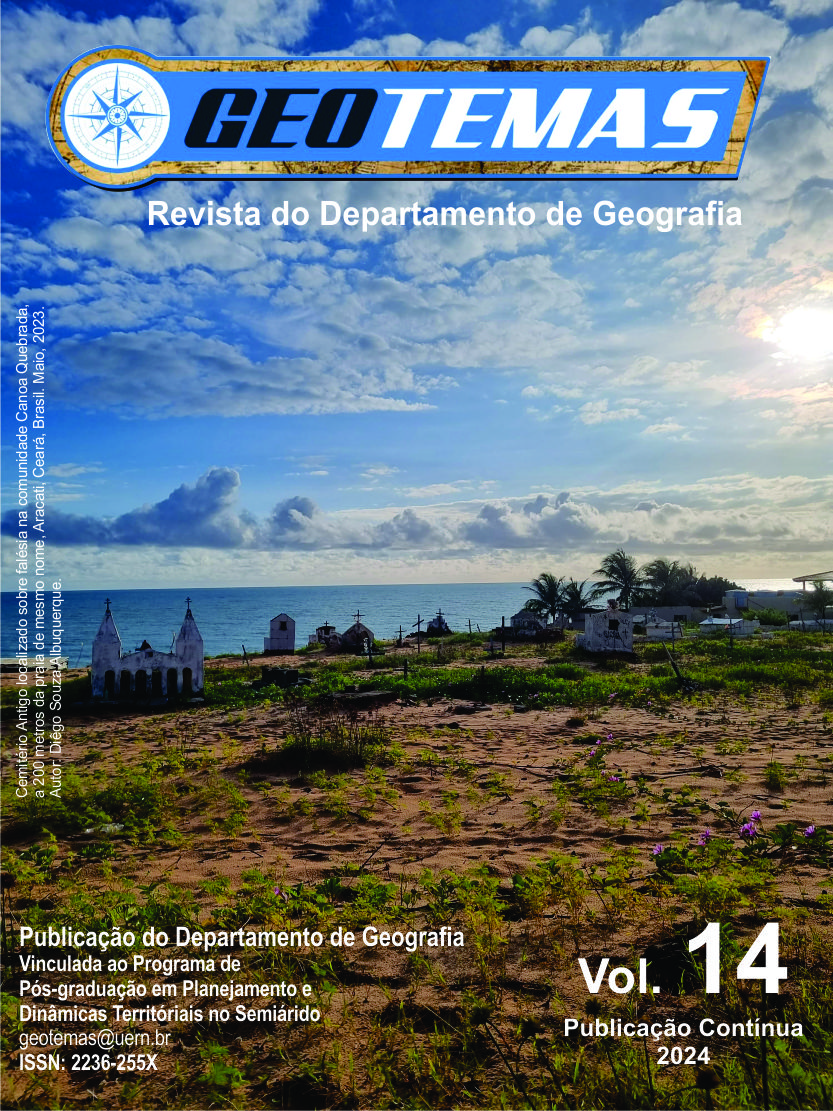ANÁLISE ESPAÇO-TEMPORAL DO USO E COBERTURA DA TERRA DA ZONA COSTEIRA DO CONDE, BAHIA
DOI:
https://doi.org/10.33237/2236-255X.2024.6197Palavras-chave:
Uso e Ocupação, MapBiomas, Gestão AmbientalResumo
Esse estudo analisa as mudanças espaço-temporais do uso e ocupação da terra da zona costeira do município do Conde, estado da Bahia, tomando como base intervalos decenais, utilizando dados dos anos de 1985,1995, 2005, 2015 e 2022, da base de informações do MapBiomas. A pesquisa considera, como premissa inicial a partir de estudos pretéritos, que o desenvolvimento econômico e social tem desencadeado mudanças positivas e negativas no ambiente. O monitoramento desses impactos é essencial para manter o equilíbrio nas relações que fazem parte do ambiente enquanto sistema substrato para a vida, fonte de recursos naturais e de serviços como conservação da água, solo e fixação de carbono. Os procedimentos metodológicos envolveram a coleta de dados bibliográficos e obtenção de imagens de satélite da plataforma MapBiomas, por meio do Google Earth Engine e posterior vetorização, classificação, coleta de geometrias, uso de calculadora de campo no software QGIS. Foram elaborados mapas, gráficos, quadros e tabelas que subsidiaram essa análise e que resultou na identificação da Formação Florestal como classe com expressiva perda, ao longo dos anos, para Pastagem e Mosaico de Usos. Os resultados obtidos nesse estudo refletem a necessidade de uma Gestão Ambiental mais efetiva na Área de Proteção Ambiental do Litoral Norte, que torne viável um uso mais sustentável da terra.
Downloads
Referências
BAHIA. Decreto Estadual nº 1.046 de 17 de março de 1992. Cria a Área de Proteção Ambiental do Litoral Norte do Estado da Bahia. Disponível em: https://www.icmbio.gov.br/cepsul/images/stories/legislacao/Decretos/1992/dec_ba_1046_1992_uc_criaapalitoralnorte_ba_altrd_res_1040_1995.pdf. Acesso em: 27 fev. 2023.
BECK, U. Sociedade de risco: rumo a uma outra modernidade. São Paulo: Editora 34, p. 384, 2011.
BRASIL. Lei nº 9.985, de 18 de julho de 2000. Institui o Sistema Nacional de Unidades de Conservação da Natureza e dá outras providências. Disponível em https://www.planalto.gov.br/ccivil_03?leis/l9985.htm. Acesso em: 27 fev. 2023.
CARVALHO, W. S.; MAGALHÃES FILHO, F. J. C.; SANTOS, T. L. Uso e cobertura da terra utilizando a Plataforma Google Earth Engine (GEE): Estudo de caso em uma unidade de conservação. Brazilian Journal of Development, v. 7, n. 2, p. 15280-15300, 2021. DOI: https://doi.org/10.34117/bjdv7n2-243.
DUTRA, D. J.; BRIANEZI, D.; COELHO, C. W. Uso de Geotecnologias para Análise da Dinâmica da Vegetação da Sub-bacia do Ribeirão Serra Azul, MG. Anuário do Instituto de Geociências - UFRJ, 43, p. 283-292, 2020.
IBGE – Instituto Brasileiro de Geografia e Estatística. Divisão regional do Brasil em mesorregiões e microrregiões geográficas. Volume 1, p. 137, 1990. Disponível em https://biblioteca.ibge.gov.br/visualizacao/livros/liv2269_1.pdf. Acesso em: 27 fev. 2023.
IBGE – Instituto Brasileiro de Geografia e Estatística. Cidades e Estados do Brasil. 2010. Disponível em https://cidades.ibge.gov.br/brasil/ba/conde/panorama. Acesso em 27 fev. 2023.
LACAZE, J-P. O ordenamento do território. Lisboa: Instituto Piaget, 1. ed., p. 140, 1998.
LEOPOLD, A. A ética da terra. Curitiba: Appris Editoria, 1. ed., p. 83, 2020.
MORAES, A. C. R. Contribuições para a gestão da zona costeira do Brasil: elementos para uma geografia do litoral brasileiro. São Paulo: Annablume, 2007.
RIBEIRO, O. J.; SCHIEBELBEIN, L. M. O geoprocessamento como ferramenta de gestão urbana. Revista TechnoEng, v. 1, n. 9, jan./jun. 2014.
SANTOS, M. A urbanização brasileira. São Paulo: EDUSP, 5. ed., v. 1, p. 176, 2023.
SANTOS, T. C. C; CÂMARA, J. B. D. Geo Brasil 2002: Perspectivas do Meio Ambiente no Brasil. Edições IBAMA. Brasília: IEAPM. 2002.
SEMARH. Ministério do Meio Ambiente. Secretaria de Meio Ambiente e Recursos Hídricos. Centro de Recursos Ambientais- CRA. Projeto de Gerenciamento Costeiro. Gestão Integrada da Orla Marítima no Município do Conde no Estado da Bahia. Diagnóstico Sócio-Econômico e Ambiental do Conde. Salvador, 2003.
SILVA, L. P. Modelagem e Geoprocessamento na identificação de áreas com risco de inundação e erosão na bacia do rio Cuiá. Dissertação (Mestrado em Engenharia Urbana) - Centro de Tecnologia, Universidade Federal da Paraíba, João Pessoa, 2007.
SOUZA, C. M., Jr. et al. Reconstructing Three Decades of Land Use and Land Cover Changes in Brazilian Biomes with Landsat Archive and Earth Engine. Remote Sensing. 12(17), 2735. 2020. DOI: https://doi.org/10.3390/rs12172735.
VAEZA, R. F.; OLIVEIRA FILHO, P. C.; MAIA, A. G.; DISPERATI, A. A. Uso e ocupação do solo em bacia hidrográfica urbana a partir de imagens orbitais de alta resolução. Floresta e Ambiente, v. 17, n. 1, p. 23-29, 2010. DOI: http://doi.org10.4322/floram.2011.003.
VALÉRIO FILHO, M.; SERAFIM, C. R.; PEREIRA, M. N.; ALVES, M. Análise temporal do crescimento urbano em áreas de risco à erosão com o suporte das geotecnologias. In: SIMPÓSIO BRASILEIRO DE SENSORIAMENTO REMOTO, 12., 2005, Goiânia. Anais. Goiânia, INPE, p. 3927-3933, 2005.
VIEIRA, P. F.; BERKES, F.; SEIXAS, C. S. Gestão integrada e participativa de recursos naturais: conceitos, métodos e experiências. Florianópolis: Editora Secco, p. 415, 2005.
Downloads
Publicado
Como Citar
Edição
Seção
Licença
Copyright (c) 2024 Revista Geotemas

Este trabalho está licenciado sob uma licença Creative Commons Attribution 4.0 International License.
Os autores que submeterem seus manuscritos para a Geotemas declaram que o trabalho trata-se de artigo original, não tendo sido submetido para publicação, na íntegra ou em parte, em outro periódico científico nacional ou internacional ou em outro veículo de circulação. Os autores declaram também que concordam com a transferência dos direitos autorais do referido artigo para a revista Geotemas (Universidade do Estado do Rio Grande do Norte), permitindo publicações posteriores, desde que seja assegurada a fonte de sua publicação. Assumem, por fim, a responsabilidade pública pelo artigo, estando cientes de que poderão incidir sobre os mesmos os eventuais encargos decorrentes de reivindicação, por parte de terceiros, em relação à autoria do trabalho.
























